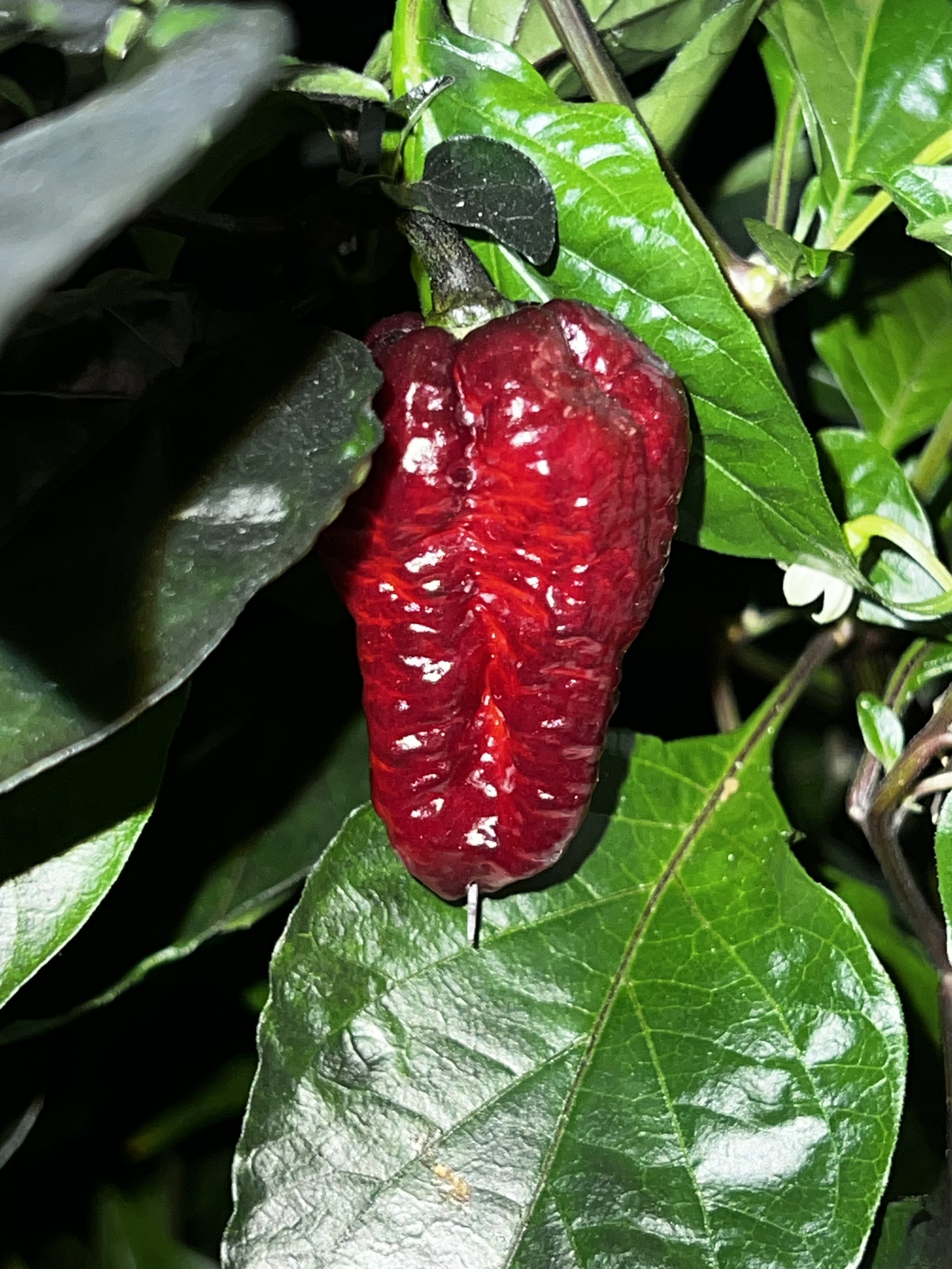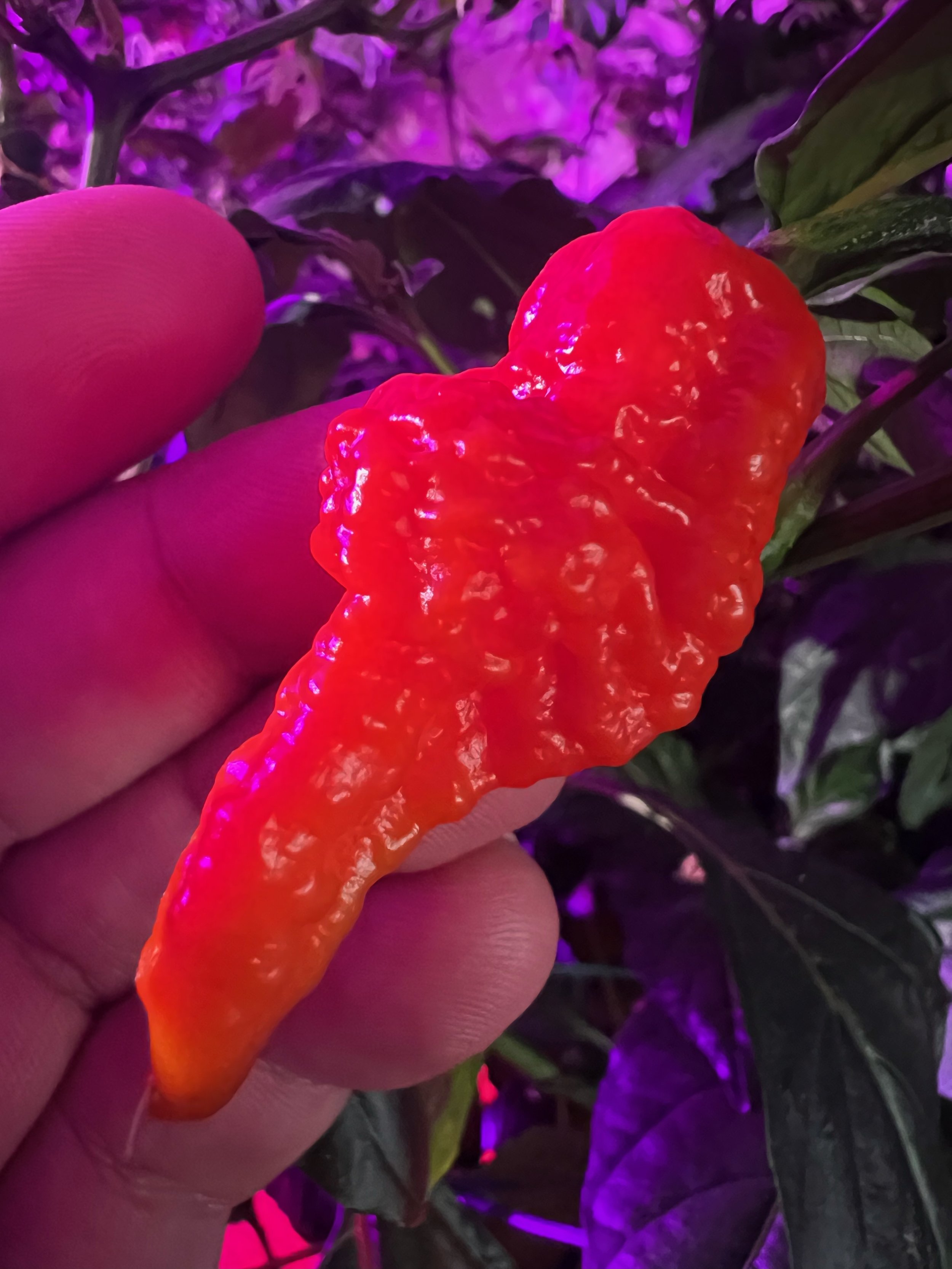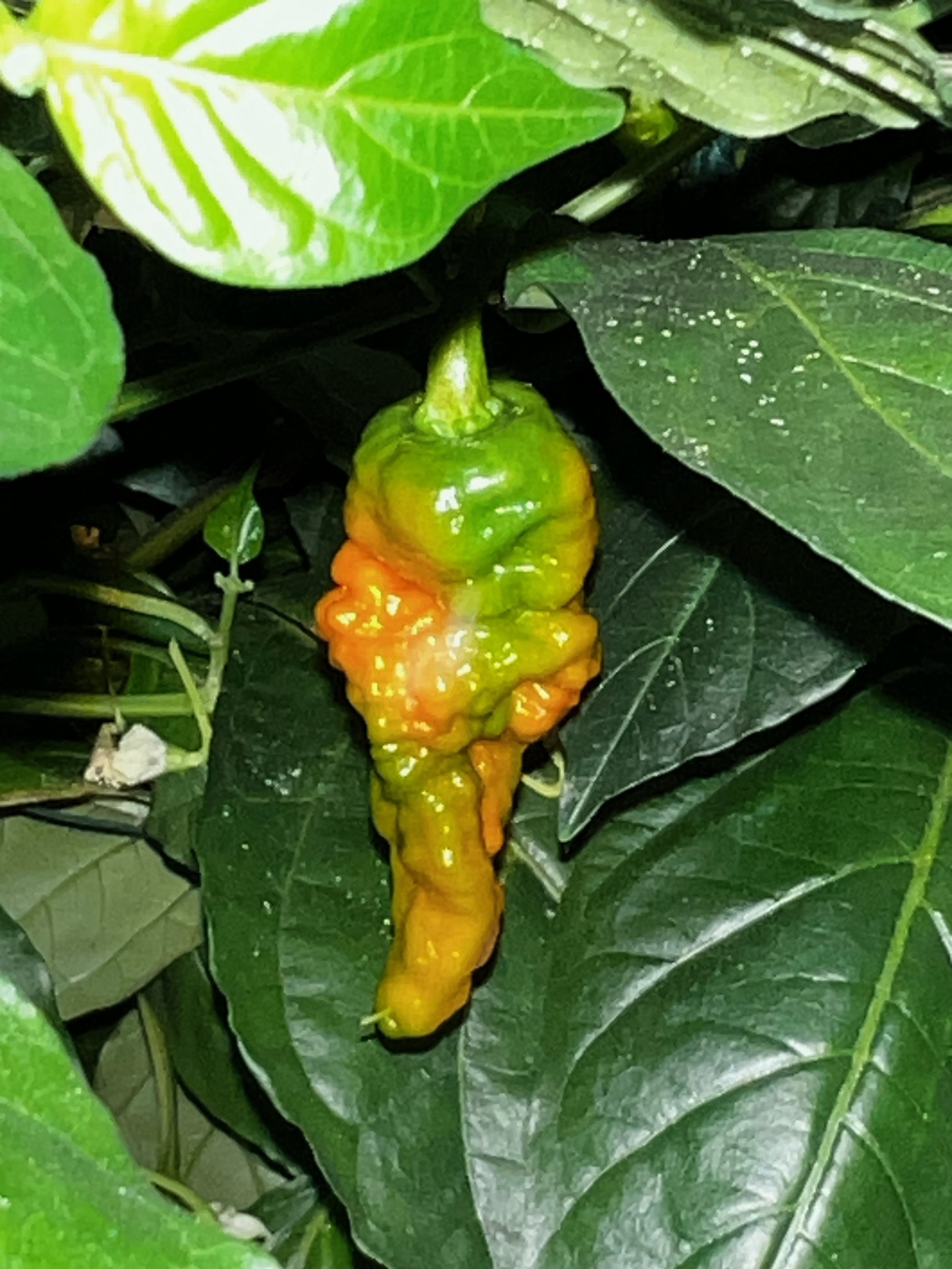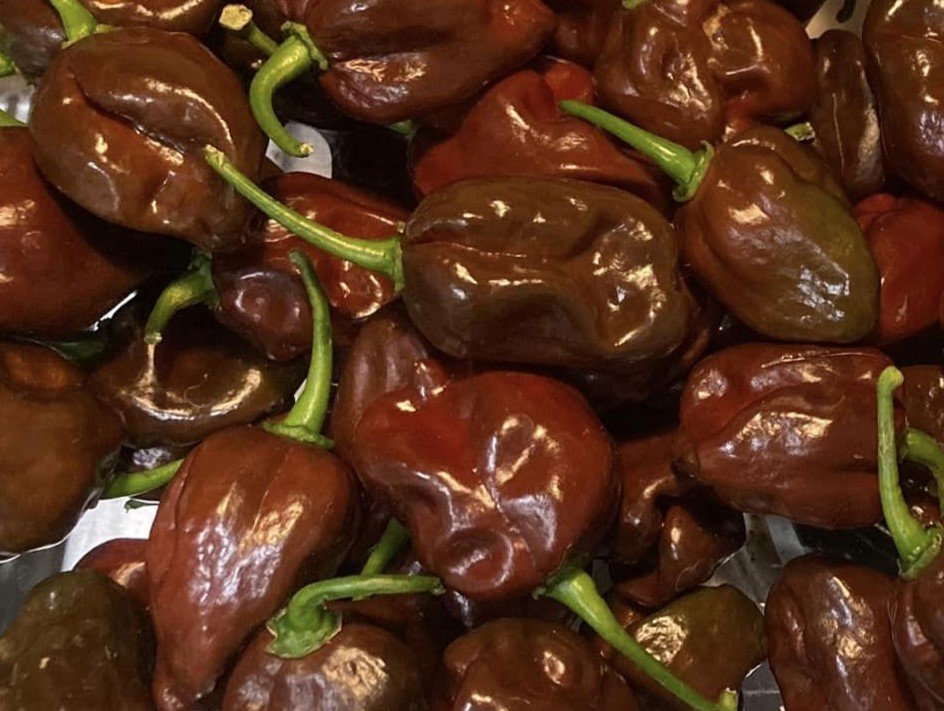 Image 1 of 3
Image 1 of 3

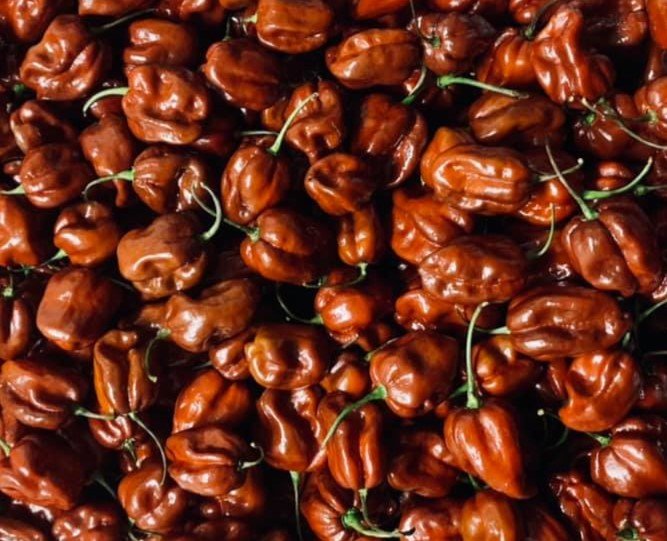 Image 2 of 3
Image 2 of 3

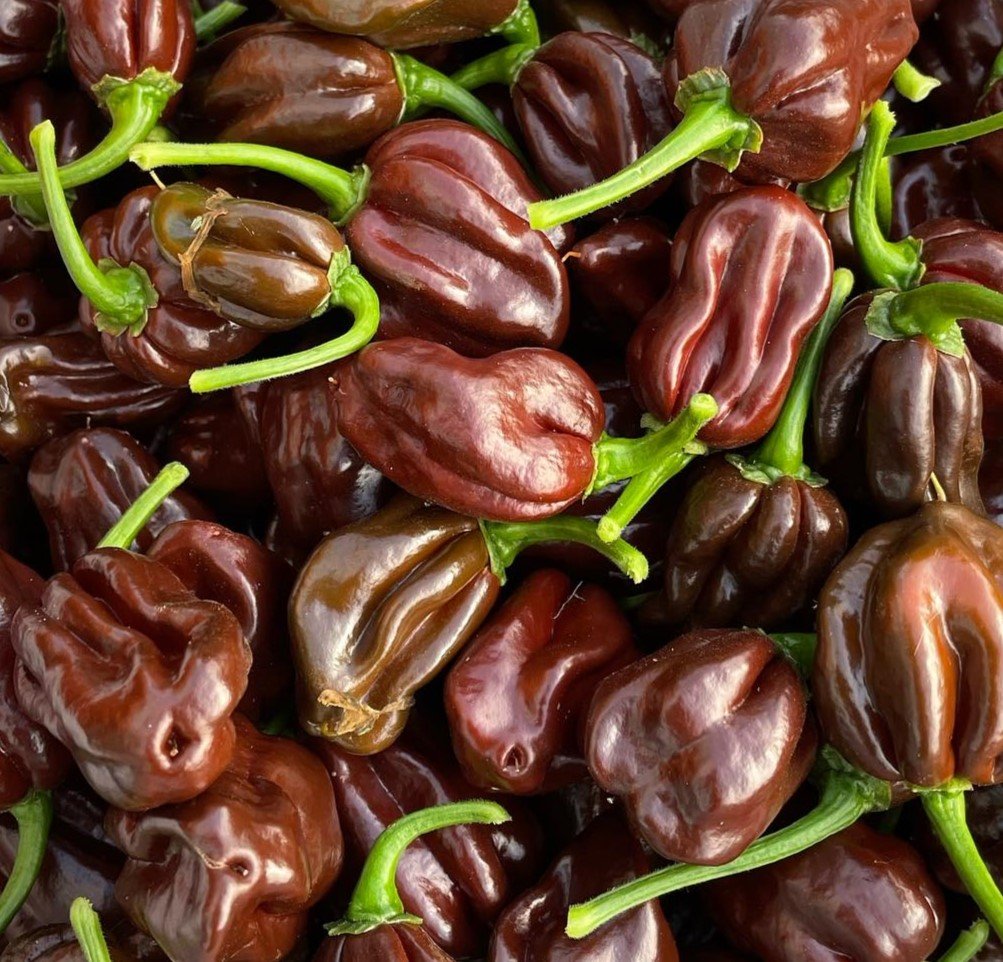 Image 3 of 3
Image 3 of 3




Chocolate Habanero Seeds
Chocolate habanero peppers, scientifically known as Capsicum chinense, are a spicy chili pepper variety that belongs to the habanero family. They are called "chocolate" habaneros due to their dark brown or chocolate-colored skin, which distinguishes them from the more common orange or red habanero peppers. Chocolate habaneros are native to the Yucatan Peninsula in Mexico and are also known by other names like "Congo black" or "black habanero."
Here are some key characteristics and information about chocolate habanero peppers:
Heat Level: Chocolate habaneros are extremely hot, measuring between 425,000 to 577,000 Scoville Heat Units (SHU). This makes them significantly hotter than a typical jalapeño pepper, which ranges from 2,500 to 8,000 SHU.
Flavor: Despite their intense heat, chocolate habanero peppers have a unique and fruity flavor with a hint of smokiness. This fruity undertone makes them a popular choice in hot sauces, salsas, and marinades, adding both heat and a complex flavor profile.
Appearance: As mentioned, they are named for their dark brown to chocolate-colored skin, which may have wrinkles or creases. They are usually small, around 1-2 inches in length, and have a lantern or bell-like shape with a distinct wrinkled appearance.
Culinary Uses: Chocolate habanero peppers are used in a variety of culinary dishes, particularly in Mexican and Caribbean cuisines. They are added to salsas, hot sauces, and marinades to provide a fiery kick and flavor. Their fruity notes also make them a good choice for adding heat to chocolate-based recipes or as a spice in rich, savory dishes.
Growing: Chocolate habanero plants are perennials that can be grown in warm climates. They require well-drained soil and plenty of sunlight to thrive. They are typically grown as annuals in cooler regions. The peppers can be harvested when they reach their mature chocolate-brown color.
Scoville Scale: The Scoville Scale is a measurement of the spiciness or heat of chili peppers. As mentioned, chocolate habaneros can range from 425,000 to 577,000 SHU on this scale. They are among the hottest chili peppers available.
Health Benefits: Like many hot peppers, chocolate habaneros contain capsaicin, a compound that may offer certain health benefits when consumed in moderation. It is believed to have potential for pain relief, metabolism-boosting properties, and antioxidant effects.
Due to their intense heat, it's important to handle chocolate habanero peppers with care, using gloves when cutting and deseeding them. Be cautious when adding them to dishes, as a little goes a long way in terms of spiciness. If you enjoy spicy foods, the unique flavor and heat of chocolate habanero peppers can add depth and excitement to your culinary creations.
*1 pack is ~12 seeds*
Chocolate habanero peppers, scientifically known as Capsicum chinense, are a spicy chili pepper variety that belongs to the habanero family. They are called "chocolate" habaneros due to their dark brown or chocolate-colored skin, which distinguishes them from the more common orange or red habanero peppers. Chocolate habaneros are native to the Yucatan Peninsula in Mexico and are also known by other names like "Congo black" or "black habanero."
Here are some key characteristics and information about chocolate habanero peppers:
Heat Level: Chocolate habaneros are extremely hot, measuring between 425,000 to 577,000 Scoville Heat Units (SHU). This makes them significantly hotter than a typical jalapeño pepper, which ranges from 2,500 to 8,000 SHU.
Flavor: Despite their intense heat, chocolate habanero peppers have a unique and fruity flavor with a hint of smokiness. This fruity undertone makes them a popular choice in hot sauces, salsas, and marinades, adding both heat and a complex flavor profile.
Appearance: As mentioned, they are named for their dark brown to chocolate-colored skin, which may have wrinkles or creases. They are usually small, around 1-2 inches in length, and have a lantern or bell-like shape with a distinct wrinkled appearance.
Culinary Uses: Chocolate habanero peppers are used in a variety of culinary dishes, particularly in Mexican and Caribbean cuisines. They are added to salsas, hot sauces, and marinades to provide a fiery kick and flavor. Their fruity notes also make them a good choice for adding heat to chocolate-based recipes or as a spice in rich, savory dishes.
Growing: Chocolate habanero plants are perennials that can be grown in warm climates. They require well-drained soil and plenty of sunlight to thrive. They are typically grown as annuals in cooler regions. The peppers can be harvested when they reach their mature chocolate-brown color.
Scoville Scale: The Scoville Scale is a measurement of the spiciness or heat of chili peppers. As mentioned, chocolate habaneros can range from 425,000 to 577,000 SHU on this scale. They are among the hottest chili peppers available.
Health Benefits: Like many hot peppers, chocolate habaneros contain capsaicin, a compound that may offer certain health benefits when consumed in moderation. It is believed to have potential for pain relief, metabolism-boosting properties, and antioxidant effects.
Due to their intense heat, it's important to handle chocolate habanero peppers with care, using gloves when cutting and deseeding them. Be cautious when adding them to dishes, as a little goes a long way in terms of spiciness. If you enjoy spicy foods, the unique flavor and heat of chocolate habanero peppers can add depth and excitement to your culinary creations.
*1 pack is ~12 seeds*
Chocolate habanero peppers, scientifically known as Capsicum chinense, are a spicy chili pepper variety that belongs to the habanero family. They are called "chocolate" habaneros due to their dark brown or chocolate-colored skin, which distinguishes them from the more common orange or red habanero peppers. Chocolate habaneros are native to the Yucatan Peninsula in Mexico and are also known by other names like "Congo black" or "black habanero."
Here are some key characteristics and information about chocolate habanero peppers:
Heat Level: Chocolate habaneros are extremely hot, measuring between 425,000 to 577,000 Scoville Heat Units (SHU). This makes them significantly hotter than a typical jalapeño pepper, which ranges from 2,500 to 8,000 SHU.
Flavor: Despite their intense heat, chocolate habanero peppers have a unique and fruity flavor with a hint of smokiness. This fruity undertone makes them a popular choice in hot sauces, salsas, and marinades, adding both heat and a complex flavor profile.
Appearance: As mentioned, they are named for their dark brown to chocolate-colored skin, which may have wrinkles or creases. They are usually small, around 1-2 inches in length, and have a lantern or bell-like shape with a distinct wrinkled appearance.
Culinary Uses: Chocolate habanero peppers are used in a variety of culinary dishes, particularly in Mexican and Caribbean cuisines. They are added to salsas, hot sauces, and marinades to provide a fiery kick and flavor. Their fruity notes also make them a good choice for adding heat to chocolate-based recipes or as a spice in rich, savory dishes.
Growing: Chocolate habanero plants are perennials that can be grown in warm climates. They require well-drained soil and plenty of sunlight to thrive. They are typically grown as annuals in cooler regions. The peppers can be harvested when they reach their mature chocolate-brown color.
Scoville Scale: The Scoville Scale is a measurement of the spiciness or heat of chili peppers. As mentioned, chocolate habaneros can range from 425,000 to 577,000 SHU on this scale. They are among the hottest chili peppers available.
Health Benefits: Like many hot peppers, chocolate habaneros contain capsaicin, a compound that may offer certain health benefits when consumed in moderation. It is believed to have potential for pain relief, metabolism-boosting properties, and antioxidant effects.
Due to their intense heat, it's important to handle chocolate habanero peppers with care, using gloves when cutting and deseeding them. Be cautious when adding them to dishes, as a little goes a long way in terms of spiciness. If you enjoy spicy foods, the unique flavor and heat of chocolate habanero peppers can add depth and excitement to your culinary creations.
*1 pack is ~12 seeds*
Disclaimer for Non-Isolated Pepper Seeds
Thank you for choosing to purchase our pepper seeds. We want to ensure that you are well-informed about the nature of the seeds you are acquiring. Please take a moment to read and understand the following disclaimer:
1. Cross-Pollination Possibility: The pepper seeds you are purchasing have not been isolated from other pepper varieties. This means that there is a possibility of cross-pollination occurring in your garden or growing environment. Cross-pollination can result in plants that exhibit characteristics of both parent plants, potentially leading to unexpected variations in the peppers grown from these seeds.
2. Genetic Variability: Cross-pollination may introduce genetic variability, resulting in peppers that differ in flavor, size, color, or other characteristics from the parent pepper plants. While this can be an exciting aspect of growing peppers, it is essential to be aware that the outcome may not always match the characteristics of the original pepper variety.
3. No Guarantee of Purity: Due to the potential for cross-pollination, we cannot guarantee the purity of the pepper seeds you purchase. They may not produce peppers that are identical to the parent plant or the variety description.
4. Best Practices: To minimize the risk of cross-pollination, we recommend following best practices for growing and isolating pepper plants. This may include physical separation, distance, or timing of planting to avoid cross-pollination with other pepper varieties.
5. No Refunds or Returns: As cross-pollination is a natural process and beyond our control, we regret that we cannot offer refunds or accept returns based on the characteristics of peppers grown from these seeds.
By purchasing these pepper seeds, you acknowledge and accept the potential for cross-pollination and the variability it may introduce. We encourage you to embrace the adventure of growing unique peppers and experimenting with new flavors and traits.
If you have any questions or concerns about our pepper seeds or need guidance on growing practices, please feel free to contact us. We are here to assist you in any way we can.
Thank you for choosing our pepper seeds and for your understanding of the inherent variability in non-isolated seed varieties.
Sincerely,
Cary Meltzer - Owner/CEO Hydro Peppers LLC






